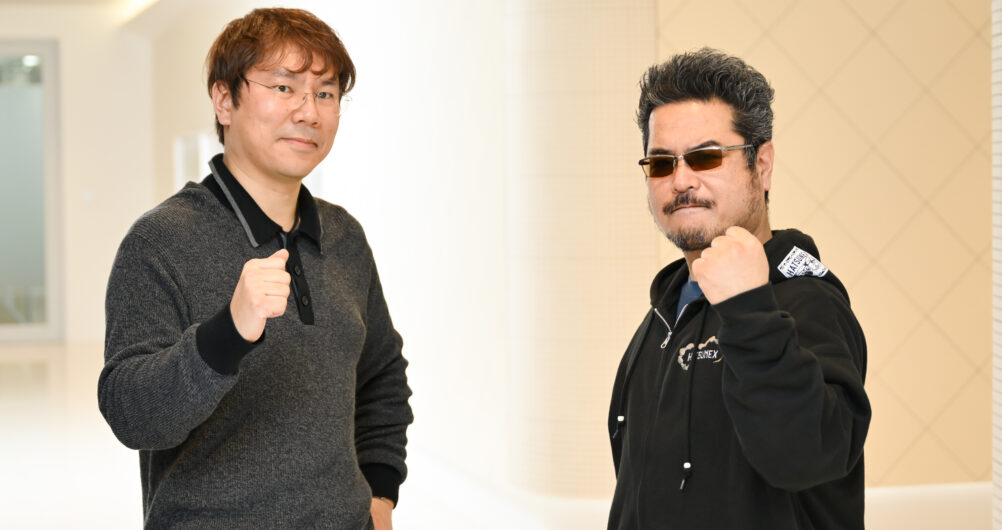Hiroyuki Kobayashi & Game Producers Interview Part 4
This is the fourth installment of a special interview series where Hiroyuki Kobayashi, the President of GPTRACK50, sits down with top industry creators. This time, guest is Katsuhiro Harada, producer and director at Bandai Namco Studios.
In this discussion, they share insights into their creative approaches and the essential qualities required for producers.
Hiroyuki Kobayashi
GPTRACK50 President
At Capcom, has been involved in many popular series such as “Resident Evil” and “Sengoku BASARA.” In 2022, established the game studio “GPTRACK50” and is currently developing a completely new title.
Katsuhiro Harada
Bandai Namco Studios Producer / Director
Executive Game Director and Chief Producer of the Tekken series. He has also worked on titles such as Summer Lesson and the Soulcalibur series.
From the New Game in Development to Behind-the-Scenes Stories—
Was All of Kobayashi’s Information an Open Secret!?
Kobayashi: I’ve had the chance to meet and greet you, Harada-san, at events and shows, but we’ve never gone out for drinks together, have we?
Harada: Yeah, we often run into each other backstage in the waiting rooms at shows. Other than that, we sometimes meet at platform-holder parties after events. At Tokyo Game Show, for example, there was a gathering where industry folks got together for drinks—you were there, too. So, thinking about it, we’ve never really had a one-on-one conversation.
Kobayashi: When I think of you, Harada-san, I see you as a leading figure in the fighting game genre, and you have a very friendly way of engaging with the community.
Harada: Friendly at times… and at war at others! (laughs)
Kobayashi: You’re also very active in esports tournaments and overseas events. I was at The Game Awards 2024 (TGA 2024) in person, so I got to see your stage appearance up close.
Harada: For me, Kobayashi-san is strongly associated with Sengoku BASARA. Actually, your name comes up quite a lot in conversations among fellow industry creators and developers. So even though we haven’t interacted much directly, I’ve somehow always had a sense of what you’ve been up to.
Kobayashi: Seriously!? That makes me a bit uncomfortable! (laughs)
Harada: This was a few years ago, but I kept hearing updates—like what you were working on and what your next move would be. I remember thinking, “Stage production? There’s a game producer handling not just game development but also theater?” Every time I heard something new, I thought, “This guy is heading in a really interesting direction.” At some point, I just assumed you had fully transitioned into producing plays and theater! (laughs)
Kobayashi: Back then, I was having a great time doing that.
Harada: While expanding your work into different areas, how did you handle game development in parallel?
Kobayashi: Actually, I’ve never worked as a director.
Harada: Wait, really?
Kobayashi: I started in the industry as a programmer and worked on the first Resident Evil. Then, I moved into planning and got involved with Dino Crisis, among other titles. At some point, Shinji Mikami told me, “You should become a producer.” That’s how I transitioned into the role, and from there, I started handling various projects.
Harada: That’s quite an unusual career path. Maybe that’s why your work spans so many areas.
Kobayashi: In the end, directors are at the center of game development. Producers can guide a project in a better direction by considering sales and overall strategy, but the director has the final call on in-game adjustments. If a producer gets too involved in those details, they become an annoying presence. So, I intentionally draw a clear line and step back from that. Instead, I focus on what I can do during development. That often means putting a lot of effort into boosting awareness and marketing the game. Before I knew it, that led me to producing stage plays as well.
Harada: Branding is a crucial part of a producer’s job.
Kobayashi: That was especially true for Sengoku BASARA. It wasn’t just about the stage production; we expanded into manga, anime, novels, and all sorts of media.
Engaging with ‘Tekken’ Fans Worldwide—
Pursuing User Needs
Kobayashi: Harada-san, is your official title Tekken series producer?
Harada: It actually changes slightly depending on the title—sometimes it’s Executive Producer, sometimes Executive Director, or something along those lines. (laughs)
Kobayashi: There are other directors working on the Tekken series besides you, right?
Harada: Yes. The director and development producer is Kohei Ikeda, though I call him “Nakatsu.” There are also producers on the publisher side, and we all work together, discussing various aspects of development and operations.
Kobayashi: So, you handle coordination between development and publishing?
Harada: That’s right. Since I get involved in both, I’m probably seen as a troublesome guy…
Kobayashi: When I was an Executive Producer at my previous job, we had separate producers for development and marketing. I had to listen to both sides and keep things running smoothly. Playing that balancing role is extremely important. If development pushes too hard, marketing struggles, and if marketing makes unreasonable demands, development gets stuck. A good balance between the two is essential.
Harada: Another thing I always keep in mind is making sure that when something goes well, the credit goes to the team. But if something goes wrong, I take responsibility—or rather, I accept that I’ll be the one people blame.
Kobayashi: That makes you a great boss! By the way, given your position, you probably can’t check everything yourself anymore, but is there something you always make sure to oversee personally?
Harada: Listening to real feedback from Tekken fans. I don’t just check social media and online forums—I also travel to esports tournaments and events worldwide. Watching fans play Tekken in person and hearing their direct opinions is something I’ve always done. When you do this year-round, you start to see patterns—different regions have different perspectives, but by studying all the feedback, you can identify core user needs that apply to all Tekken fans. Then, I check whether we’re meeting those needs and ensure we’re not straying too far from what players want. Of course, sometimes we do miss the mark…
Kobayashi: It’s impressive that you still handle that process yourself.
Harada: Well, that’s why I trust Nakatsu and the team’s instincts for everything else. For Tekken 8, I made sure everyone on the team understood one thing from the start: What do the fans want? But I left the actual execution to them.
Kobayashi: And the result was a massive global hit. Seeing the growth of your team members under your leadership must have been rewarding.
Harada: Yeah, in the end, we got a Metascore in the 90s and won Best Fighting Game at TGA 2024. I really appreciate the recognition. Maybe Tekken can now stand on its own without me… or at least, it should be able to!
Kobayashi: No, no, no—(laughs).
Anticipating Demand, Selecting the Target—
What Are the Essential Skills for a Producer?
―The Changing Role of a Producer. How Have They Changed Over Time?
Kobayashi: In the past, game development often started with a simple idea—”Hey, this seems fun!”—and we would just go from there. If we had a team with enough experience, things would somehow turn into a successful sale. But nowadays, just being fun isn’t enough to sell a game. We need thorough marketing, clear analysis of target demographics, and a well-defined audience before development even begins. Our current project is aimed at the global gaming market, and I’ll just say it now—it probably won’t sell much in Japan.
Harada: So, you’ve already accepted that.
Kobayashi: Yes, because if we don’t make that clear from the start, midway through development, someone will say, “Maybe we should also make this appeal to the Japanese market.” If we try to accommodate that, the entire direction of the game gets thrown off the course. That’s why we establish a clear vision—”This game is for this audience.”
Harada: I completely agree. The process of shaping a concept today is totally different from the past. Back in the ’90s, when we were developing Tekken, we could push forward purely on our passion—”This is the kind of fighting game we want to make!”—and players would follow. But today, with so many entertainment options available, we need to be very specific in defining our target audience.
Kobayashi: That kind of analysis and audience targeting has become an essential part of a producer’s job.
Harada: On top of that, we also have to think about what happens after launch—how the players will engage with the game, how the community will grow. As producers, we need to anticipate these trends during the planning phase. We have to map out how our game will create demand and ensure those needs are met within the game’s design.
Kobayashi: If we wait until after the launch to address player feedback, it’s already too late.
Harada: Exactly. Developing high-quality content takes at least one or two years. If we react post-launch, we miss the window to capitalize on peak excitement. Take Tekken 8’s TEKKEN FIGHT LOUNGE, for example. We predicted that players would want a social hub in-game. But something that complex can’t be tacked on later—it had to be developed in parallel with the main game. That’s why we made it a core feature from the start.
Kobayashi: Another critical point is rating restrictions. You’ve directed games yourself, but in my case, director is not myself. I like to give creative freedom, but there are two things I absolutely step in on: “whether it resonates with our target audience?” and “if it risks pushing the game into a Z rating (CERO)?”
Harada: Since Tekken has been around for decades, we’ve developed an unspoken understanding within the team. But for new studios, clear communication on this is essential.
Kobayashi: Exactly. To prevent any misalignment, we address ratings early on—right when defining the characters and world. In every design review, I emphasize: “We cannot afford a CERO Z rating—it will make selling the game far more difficult.”
Harada: Your games always feature striking, unique characters. How is that shaping up in your new project?
Kobayashi: The art director curently I’m working with is new to me, so this game will have a very different visual style compared to my past works. The character designs are unlike anything I’ve done before, so I think people will be surprised when we reveal them. I hope everyone looks forward to it.
Harada: So… when’s the release date?
Kobayashi: You really think I’d tell you? (laughs)



